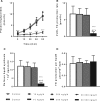Dose Effects of Ammonium Perfluorooctanoate on Lipoprotein Metabolism in APOE*3-Leiden.CETP Mice
- PMID: 30657992
- PMCID: PMC6432869
- DOI: 10.1093/toxsci/kfz015
Dose Effects of Ammonium Perfluorooctanoate on Lipoprotein Metabolism in APOE*3-Leiden.CETP Mice
Abstract
Epidemiological studies have reported positive associations between serum perfluorooctanoic acid (PFOA) and total and non-high-density lipoprotein cholesterol (non-HDL-C) although the magnitude of effect of PFOA on cholesterol lacks consistency. The objectives of this study were to evaluate the effect of PFOA on plasma cholesterol and triglyceride metabolism at various plasma PFOA concentrations relevant to humans, and to elucidate the mechanisms using APOE*3-Leiden.CETP mice, a model with a human-like lipoprotein metabolism. APOE*3-Leiden.CETP mice were fed a Western-type diet with PFOA (10, 300, 30 000 ng/g/d) for 4-6 weeks. PFOA exposure did not alter plasma lipids in the 10 and 300 ng/g/d dietary PFOA dose groups. At 30 000 ng/g/d, PFOA decreased plasma triglycerides (TG), total cholesterol (TC), and non-HDL-C, whereas HDL-C was increased. The plasma lipid alterations could be explained by decreased very low-density lipoprotein (VLDL) production and increased VLDL clearance by the liver through increased lipoprotein lipase activity. The concomitant increase in HDL-C was mediated by decreased cholesteryl ester transfer activity and changes in gene expression of proteins involved in HDL metabolism. Hepatic gene expression and pathway analysis confirmed the changes in lipoprotein metabolism that were mediated for a major part through activation of the peroxisome proliferator-activated receptor (PPAR)α. Our data confirmed the findings from a phase 1 clinical trial in humans that demonstrated high serum or plasma PFOA levels resulted in lower cholesterol levels. The study findings do not show an increase in cholesterol at environmental or occupational levels of PFOA exposure, thereby indicating these findings are associative rather than causal.
Keywords: cholesterol; lipoproteins; non-HDL cholesterol; perfluorooctanoic acid (PFOA); peroxisome proliferator-activated receptor (PPAR)α; triglycerides.
© The Author(s) 2019. Published by Oxford University Press on behalf of the Society of Toxicology.
Figures







Similar articles
-
Perfluoroalkyl sulfonates cause alkyl chain length-dependent hepatic steatosis and hypolipidemia mainly by impairing lipoprotein production in APOE*3-Leiden CETP mice.Toxicol Sci. 2011 Sep;123(1):290-303. doi: 10.1093/toxsci/kfr142. Epub 2011 Jun 24. Toxicol Sci. 2011. PMID: 21705711
-
Bexarotene induces dyslipidemia by increased very low-density lipoprotein production and cholesteryl ester transfer protein-mediated reduction of high-density lipoprotein.Endocrinology. 2009 May;150(5):2368-75. doi: 10.1210/en.2008-1540. Epub 2009 Jan 15. Endocrinology. 2009. PMID: 19147676 Clinical Trial.
-
Atorvastatin increases HDL cholesterol by reducing CETP expression in cholesterol-fed APOE*3-Leiden.CETP mice.Atherosclerosis. 2008 Mar;197(1):57-63. doi: 10.1016/j.atherosclerosis.2007.08.001. Epub 2007 Sep 14. Atherosclerosis. 2008. PMID: 17868678
-
Tenuous dose-response correlations for common disease states: case study of cholesterol and perfluorooctanoate/sulfonate (PFOA/PFOS) in the C8 Health Project.Drug Chem Toxicol. 2011 Oct;34(4):396-404. doi: 10.3109/01480545.2011.582502. Epub 2011 Jul 19. Drug Chem Toxicol. 2011. PMID: 21770727 Review.
-
Alterations in high-density lipoprotein metabolism and reverse cholesterol transport in insulin resistance and type 2 diabetes mellitus: role of lipolytic enzymes, lecithin:cholesterol acyltransferase and lipid transfer proteins.Eur J Clin Invest. 2003 Dec;33(12):1051-69. doi: 10.1111/j.1365-2362.2003.01263.x. Eur J Clin Invest. 2003. PMID: 14636288 Review.
Cited by
-
Per- and Polyfluoroalkyl Substance Toxicity and Human Health Review: Current State of Knowledge and Strategies for Informing Future Research.Environ Toxicol Chem. 2021 Mar;40(3):606-630. doi: 10.1002/etc.4890. Epub 2020 Dec 7. Environ Toxicol Chem. 2021. PMID: 33017053 Free PMC article. Review.
-
Diet as an Exposure Source and Mediator of Per- and Polyfluoroalkyl Substance (PFAS) Toxicity.Front Toxicol. 2020 Dec 4;2:601149. doi: 10.3389/ftox.2020.601149. eCollection 2020. Front Toxicol. 2020. PMID: 35296120 Free PMC article. Review.
-
Exposure to per- and Polyfluoroalkyl Substances and Markers of Liver Injury: A Systematic Review and Meta-Analysis.Environ Health Perspect. 2022 Apr;130(4):46001. doi: 10.1289/EHP10092. Epub 2022 Apr 27. Environ Health Perspect. 2022. PMID: 35475652 Free PMC article.
-
Perfluorooctanoic acid increases serum cholesterol in a PPARα-dependent manner in female mice.Arch Toxicol. 2025 May;99(5):2087-2105. doi: 10.1007/s00204-025-03984-7. Epub 2025 Mar 1. Arch Toxicol. 2025. PMID: 40021516
-
Exposure to a mixture of legacy, alternative, and replacement per- and polyfluoroalkyl substances (PFAS) results in sex-dependent modulation of cholesterol metabolism and liver injury.Environ Int. 2021 Dec;157:106843. doi: 10.1016/j.envint.2021.106843. Epub 2021 Aug 31. Environ Int. 2021. PMID: 34479135 Free PMC article.
References
-
- Bijland S., Pieterman E. J., Maas A. C., van der Hoorn J. W., van Erk M. J., van Klinken J. B., Havekes L. M., van Dijk K. W., Princen H. M., Rensen P. C. (2010). Fenofibrate increases very low density lipoprotein triglyceride production despite reducing plasma triglyceride levels in APOE*3-Leiden.CETP mice. J. Biol. Chem. 285, 25168–25175. - PMC - PubMed
-
- Bijland S., Rensen P. C., Pieterman E. J., Maas A. C., van der Hoorn J. W., van Erk M. J., Havekes L. M., Willems van Dijk K., Chang S. C., Ehresman D. J., et al. (2011). Perfluoroalkyl sulfonates cause alkyl chain length-dependent hepatic steatosis and hypolipidemia mainly by impairing lipoprotein production in APOE*3-Leiden CETP mice. Toxicol. Sci. 123, 290–303. - PubMed
-
- Bjork J. A., Butenhoff J. L., Wallace K. B. (2011). Multiplicity of nuclear receptor activation by PFOA and PFOS in primary human and rodent hepatocytes. Toxicology 288, 8–17. - PubMed
-
- Bougarne N., Weyers B., Desmet S. J., Deckers J., Ray D. W., Staels B., De Bosscher K. (2018). Molecular actions of PPARalpha in lipid metabolism and inflammation. Endocr. Rev. 39, 760–802. - PubMed
Publication types
MeSH terms
Substances
LinkOut - more resources
Full Text Sources
Miscellaneous

